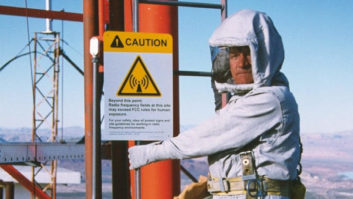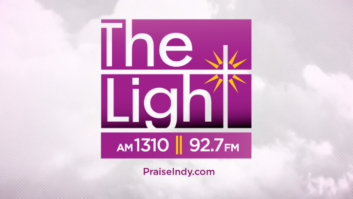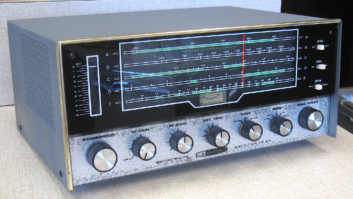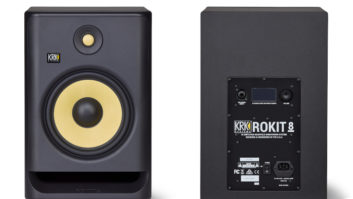Guy Wire Says: C’mon, Boys, Wake Up and Smell the Radio
I’ll never forget my first experience installing a Harris MW-1 transmitter in the fall of 1978. This solid-state thoroughbred with a new Optimod 9000 sounded great but was real picky about antenna bandwidth. The rig would shut down on the night antenna during modulation peaks. My five-tower in-line array just didn’t like it.
Broadbanding that pencil beam looked pretty hopeless, although we did make some improvements with it later on. Decreasing the VSWR protection trip-point rewarded me with a pile of dead PA transistors. I initially found relief by rolling off much of the high-end boost and reducing modulation. But the best final fix included maintaining pre-emphasis from 2 to 5 kHz and installing a high-quality 5 kHz lowpass filter at the Optimod input. Modulation was then cranked up with no problems.
I could hear the obvious difference on the wideband Belar modulation monitor using the filter and first thought a 5 kHz cutoff sounded dreadful. This was during the pre-NRSC era, so reducing 12 kHz audio down to only 5 kHz on a music station was going to be brutal and would never fly with the PD. Or so I thought.
Originally I was going to use a relay triggered by day-night mode switching to engage the 5 kHz filter for nighttime only. But after listening to non-directional daytime performance on a few of my own radios with the hardwired filter running, I was surprised how bright the station sounded. So I decided to install the relay and do some additional testing switching the 5 kHz filter in and out while several of us monitored closely. After listening on dozens of radios of all flavors, it became apparent the difference was so minimal that it was almost shocking. On most car radios there was NO difference.
With the MW-1 cut off at 5 kHz, not only did the high end that was present sound cleaner, but I could also maintain higher average loudness and positive peak modulation. Obviously the antenna was part of the culprit at night, but listeners benefited even without the antenna limitations.
THE MAKING OF BAD RADIOS
How had the typical AM radio gotten so pitifully awful passing high frequencies? It wasn’t widely known back then why radio manufacturers had chosen to roll off AM response starting around 2 kHz on so many designs. The band had filled up with lots of new signals over the preceding 20 years and noise was becoming a real nuisance. But the dirty little secret fully emerged in the 1980s as FM was stealing multitudes of AM listeners. AM stereo had been adopted and was struggling to restore competitiveness for AM music formats.
The NRSC can be credited for flushing out the complete truth. Radio manufacturing companies had been focusing all of their effort on improving FM receiver performance. FM had replaced AM as the listeners’ preferred choice for music listening on a huge scale. Between 1970 and the early ’80s, the entire industry had flipped. AM had been relegated to news-talk in order to survive and didn’t need wide-bandwidth performance. AM stereo didn’t have a chance and essentially died with an inaudible whimper.
The other excuse for rolled-off AM radios always given by the manufacturers was the added “benefit” of noise reduction. Car dealers were not happy when the buyer of a new car returned it complaining how noise and interference had spoiled the radio reception.
MAKING THINGS WORSE
Noise interference had grown insidiously over the years, but a new source was not the fault of power lines, light ballasts or motors. Few wanted to admit it, but AM broadcasters provoked some of the increase in receiver high-end rolloff themselves. As AM music stations lost share to FM, PDs insisted on more brightness to compete.
New-breed, higher-performance transmitters and audio processors sporting multiband compression and EQ controls gave AM engineers a doubled-edged sword to battle back. As modulation density and the highs got turbo-charged, adjacent channel interference and noise across the band increased dramatically. The receiver boys responded by further reducing bandwidth and high-end response to cut down the annoying interference. AM has never been the same, and never will be again in the analog world.
Too many forget that prior to 1970, AM radio was largely a de facto 5 kHz transmission service. Phone line STLs, wimpy plate-modulated transmitters with only peak limiters and flat EQ all added up to a dull sound. But this combination also produced limited adjacent channel interference. Most receivers had long before rolled off everything above 5 kHz to eliminate 10 kHz carrier whistles at night. It’s prophetic we have now come full circle.
NRSC TO THE RESCUE
The NRSC held lots of meetings and commissioned studies on how to best cope with the problem. If only the receiver makers would spend some effort building a better AM section and open up the high end again. After considerable hand-wringing and worrying about how reducing transmitted bandwidth would make AM even less competitive with FM, the NRSC recommended to the commission a standardized pre-emphasis curve with a 10 kHz brick-wall limit. It seemed like the best compromise at the time and did reduce second-adjacent interference.
A few of the engineers who participated in those proceedings saw the larger picture and favored a 5 kHz limit instead of 10 kHz. Quite a few more, including Bob Orban, preferred 5 kHz for nighttime. That was around 1989. They knew the bandwidth battle for better AM had already been lost to the receiver boys. Europe had long before chosen a 4.5 kHz limit. The world was filled with AM radios that couldn’t hear much above 4 kHz, let alone anything higher.
There have been a few notable exceptions, of course. The Sony SRF-100 AM multi-mode stereo receiver, now a collectors item, was my favorite. The C. Crane radio and GE SuperRadio III both sport wide-band AM response. But sadly, only radio engineers and some fans of “AM Coast to Coast” and a few other talk shows have bought and use them. The best feature of those sets is the superb RF front end. A non-technical user chooses the mode that yields the least interference, and that’s almost never wide band.
A few car radio models still have better AM response than the vast majority of OEM or after-market radios installed in cars over the past 35 years. Some of the Chrysler/Mitsubishi products are among those. GM/Delco/Delphi have always been the most pathetic. But those that feature any response beyond 5 kHz are few and far between. Anyone who argues they can hear the difference between 5 kHz and 10 kHz transmission on most radios – including those using sharp low-pass or cheap ceramic IF filters that produce ringing artifacts – and think it’s of any importance to the AM listening public are simply self-delusional.
Hindsight is always 20/20. The NRSC really gave the safe-keepers of high-fidelity AM a half-baked concession. Only a tiny minority of AM listeners was using or ever would use a radio that could take advantage of audio above 5 kHz. Everyone else would just be subjected to the higher probability of unnecessary interference.
CONSPIRACY THEORIES
Let’s face it: The laws of physics have always conspired against transmitting wide bandwidth for AM broadcast simply because of the 9 and 10 kHz channel allocation schemes used. No other service in the entire electromagnetic spectrum was conceived and authorized to allow adjacent-channel stations to deliberately interfere with each other. You’ve got to wonder what the founding fathers of the FRC and FCC were smoking.
The only way to ensure that such interference is mostly eliminated is to reduce transmitted modulation bandwidth to 5 kHz. While this constraint is less important for interference-free daytime service, it is crucial to keep next-door neighbors out of each other’s hair at night.
With all of the foregoing revelations, it’s not hard to understand why my good friend Jeff Littlejohn at Clear Channel along with Cris Alexander at Crawford Broadcasting have taken the bold and courageous step to voluntarily limit all of their AM talk stations to 5 kHz and music stations to 6 kHz.
It’s all about facing up to reality and deferring to good common sense. A few of us saw the benefits of doing this some time ago and made the switch on our own stations, in some cases without first informing the PD. The only responses I’ve heard about were either nothing at all or in a few cases: “Hey, I think we’re sounding a bit louder and cleaner. Did you change the processor settings lately?”
In the middle of this controversy we are now hearing from those who see the self-imposed 5 kHz limit as a deliberately planned tactic of the vast pro-IBOC conspiracy. It’s all being done to “dumb down” AM performance so when HD Radio is added, nobody will hear any difference on analog radios while HD will sound “spectacular.”
Newsflash: Nobody hears it now anyway. Wake up and smell the radio. Only a few die-hard engineers still think analog AM can be or should be high fidelity. The public never thought it was. You’ll get your precious wide response plus dramatically reduced noise interference by going HD Radio.
AURAL TRUTH
Here’s the truth very few engineers who insist on high-fidelity standards for AM broadcast audio are either loathe to admit or don’t understand: The human ear and the psychoacoustic processing of the brain are much more prone to respond negatively to a listening experience degraded by noise or interference long before it is degraded by reduced frequency response.
The same applies to degradation by distortion. The typical listener is much more tolerant of even moderate levels of harmonic, intermod or quantizing distortion than they are of noise-related interference degradation that competes with their ability to easily understand or appreciate the programming content.
Some of the truth of this revelation has been hammered home in recent years by the wide acceptance of low-bit-rate MP3 audio. Audiophiles continue to wretch at the thought of giving away over 90% of the original information inflicted by lossy compression instead of acknowledging the actual sound of the results is remarkably impressive. While purists still complain about nuance degradation, consumers voted the MP3 as CD-quality long ago.
GAINS AND LOSSES
Since Clear Channel deployed the 5 kHz limit, we are hearing reports of listeners being able to hear many of the 50 kW clears at night for the first time in years in areas where nearby first-adjacent stations have made the switch to 5 kHz. Sadly that capability will be lost again as stations begin adding HD Radio. Everyone realized that making the hybrid HD-AM mode work involved some delicate compromises. But the gains will most certainly far outweigh the losses.
I have stated here many times in the past that opening up HD-AM at night is going to be painful for some stations. There will be complaints and a number of stations will be forced to reduce HD Radio carrier levels. A few may not be able to run HD at night at all. But I’m betting most of the complaints will come directly from station owners, managers and engineers themselves rather than those generated by listeners.
Only a small percentage of all radio listening occurs on AM at night. The NAB says 19% of that is AM, so less than 5% is nighttime listening. Ibiquity says only about 1% of that total will be challenged by skywave-induced digital interference to analog in protected coverage areas. We’ll have to wait and see if that’s accurate, but it seems reasonable the figure will be very low. Most of the coverage losses real listeners will experience as fulltime HD-AM ramps up could be reminiscent of what happened when AM stereo was “lost.” Folks inside the industry were very disappointed, but the public barely noticed.
How much longer do we have to listen to the small band of purists and hobbyists who loudly insist that analog AM radio can compete for the long haul in an era thoroughly dominated by so many other full-fidelity digital media choices? Put away your buggy whips, boys, and accept the reality of 5 kHz AM while the hybrid HD Radio transition phase paves the way to an all-digital AM future.







